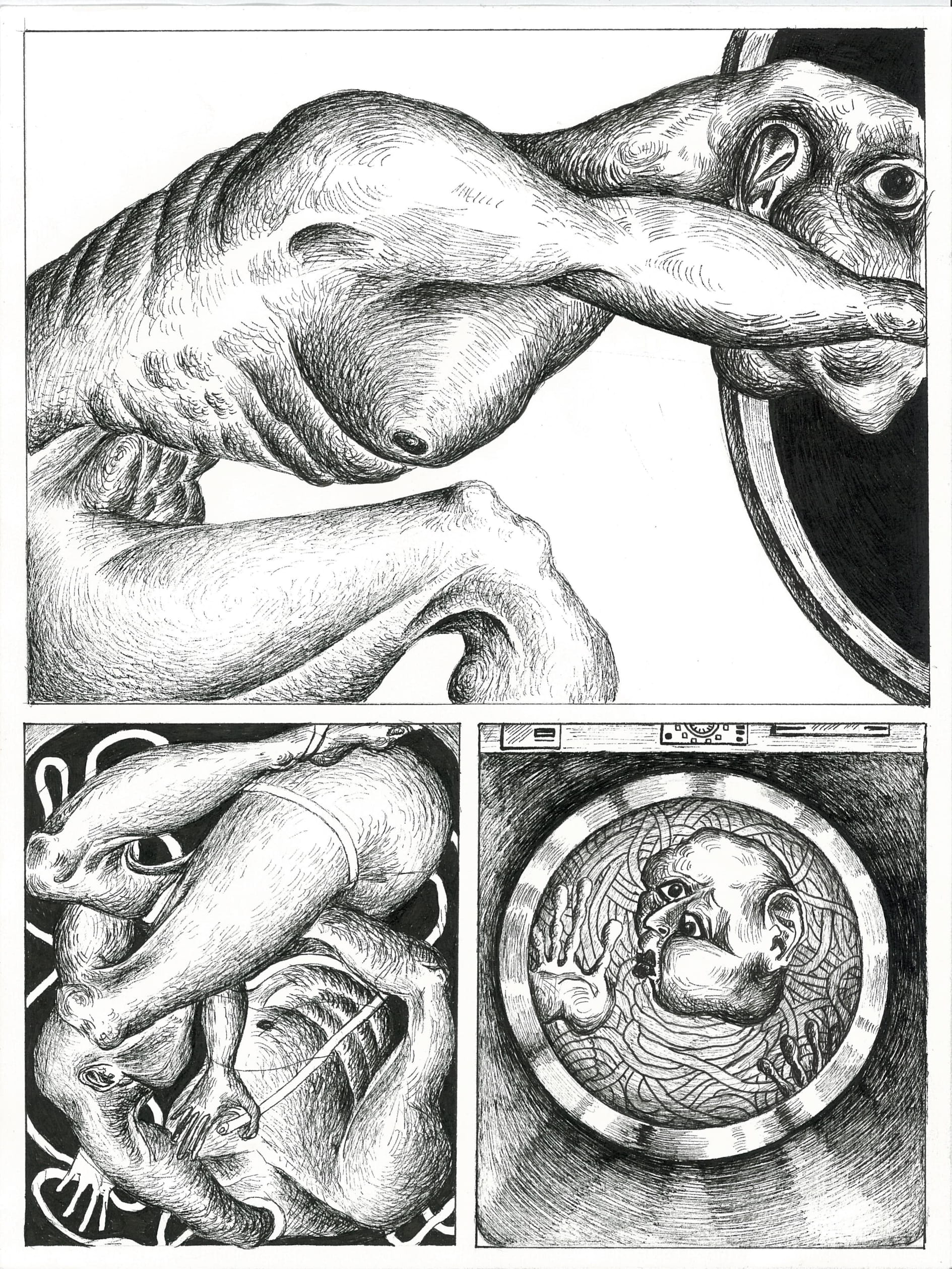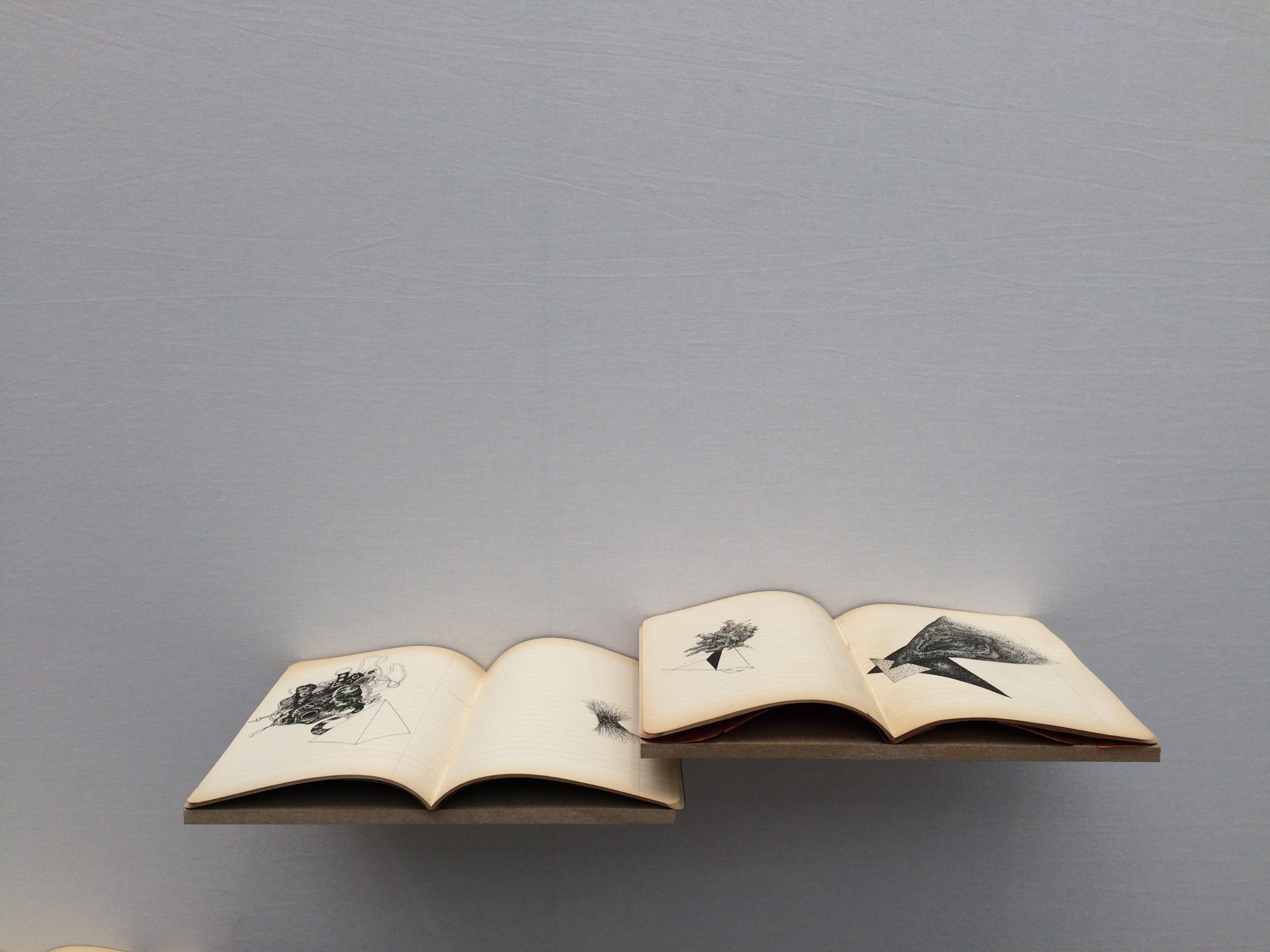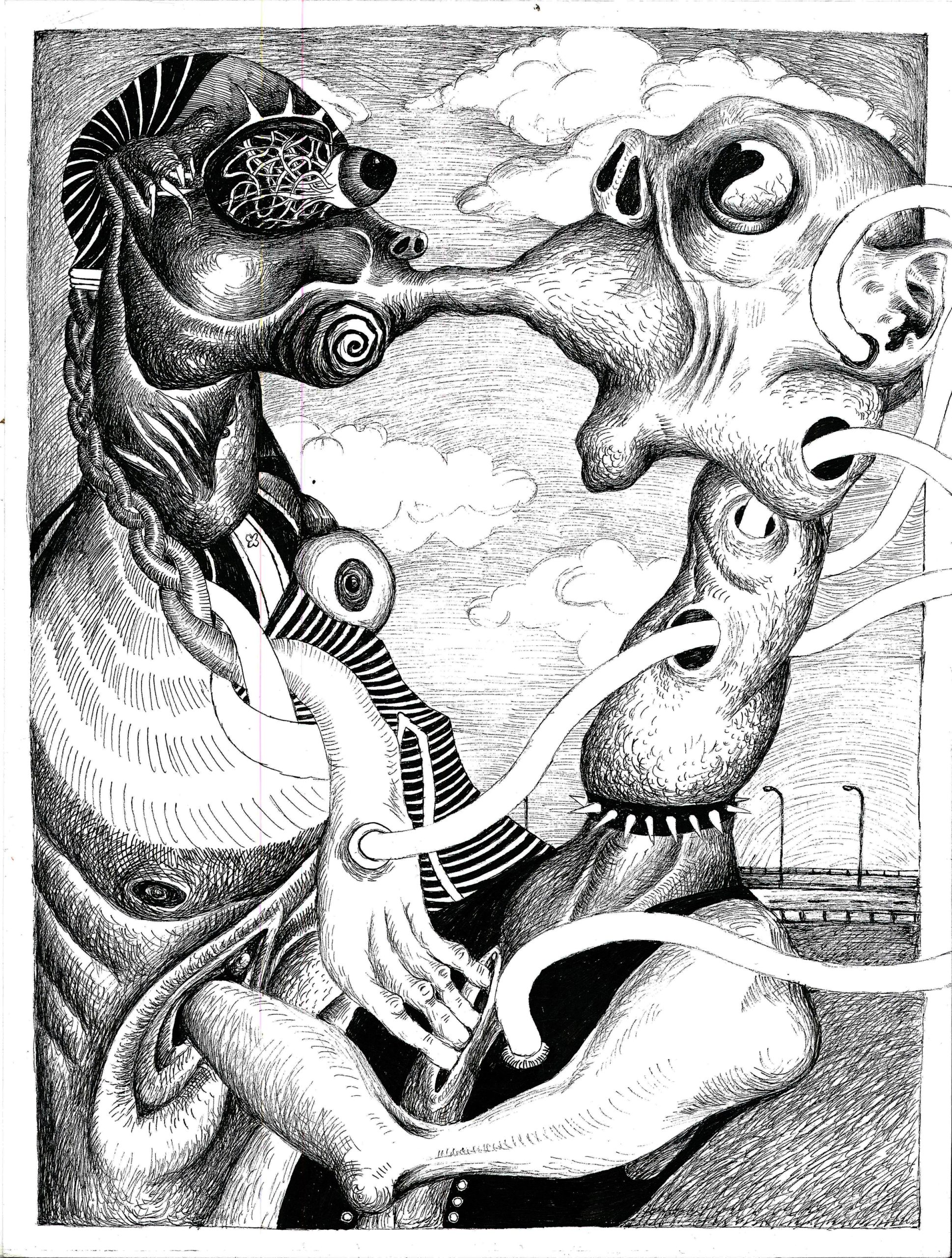Immersion dans l’univers singuliers d’Aïcha Snoussi
Nous sommes allés à la rencontre de l’univers aussi singulier qu’étrange d’Aïcha Snoussi. En effet, l’interview porte sur cette artiste tunisienne, née en 1989, qui est sans doute l’une des plus douée de sa génération. Aïcha Snoussi fait partie de ces âmes singulières comme il en existe peu. Brillante et clairvoyante, il émane de ses dessins (peintures, gravures) un sens quasi mystique et une justesse indéfinissable dans la manière de traiter les sujets qui la fascinent. Ses œuvres sont réellement le reflet de ses réflexions sur notre monde. Après un baccalauréat au lycée français Gustave Flaubert de la Marsa, puis une formation dans le cadre de l’école des Beaux-arts de Tunis, de L’ISBAT. Elle a intégré, par la suite, la résidence d’artistes au centre des Arts Vivants de Radès. Depuis 2014, elle fait partie de la résidence à la Cité des Arts de Paris. Aïcha Snoussi a donc établi un pont entre ces deux villes que sont Tunis et Paris, en exposant à la fois dans les galeries d’arts à Sidi Bou Saïd, comme celle d’Aïcha Gorgi ou dans le cas de l’exposition « Golgotha » qui prenait place dans la galerie Ammar Farhat, et à la fois, en France, lors de
Quand le dessin réinvente les sexes de l’art
Des cahiers d’écolier, aux fines lignes horizontales, Aïcha Snoussi se fait de bien perverses idées. Composé d’un ensemble de cahiers d’écoliers, distribuées dans les années cinquante au sein des écoles primaires tunisiennes, son « Livre des anomalies » claque comme une baffe dans les têtes trop pleines. Le savoir dont celles-ci se targuent n’étant pas désopilant, les dessins à l’encre noire d’Aïcha Snoussi balaient les limites du goût comme la frontière entre les sexes. Présenté du 30 mars au 02 avril 2017 sur le stand de la galerie A. Gorgi, lors de l’Art Paris Art Fair au Grand Palais, ce travail déprave avec force une large vulgate rétinienne. L’anti-savoir ? Une baffe dans les têtes À force d’inventorier les fictions du savoir, Aïcha Snoussi a fini par inventer quelque chose comme une encyclopédie visuelle de l’anti-savoir. Ce serait quoi sa devise ? On pense peut-être aux petits théâtres des archives, aux cabinets de curiosités. Mais c’est autre chose qu’expose Le livre des anomalies. Composé d’un ensemble de cahiers d’écoliers, distribués dans les années cinquante au sein des écoles primaires tunisiennes, ce travail d’Aïcha Snoussi claque en effet comme une baffe dans les têtes trop pleines. Le savoir dont celles-ci se targuent n’étant
Au fil des pages : L’étrange univers d’Aïcha Snoussi
Présentée sur le stand de la galerie A.Gorgi lors de la Art Paris Art Fair (du 30 mars au 02 avril 2017) au Grand Palais, Aïcha Snoussi est une jeune artiste tunisienne prometteuse. Née à Tunis en 1989, Aïcha Snoussi vit et travaille entre sa ville natale et Paris. Diplômée de l’Institut Supérieur des Beaux-Arts de Tunis et de l’université de la Sorbonne, la jeune femme se spécialise dans le domaine de la gravure. Par la suite, elle rejoint la résidence d’artistes du centre des Arts Vivants de Radès et intègre la résidence de la Cité des Arts de Paris en 2014. Qu’il s’agisse de réaliser des fresques murales ou de noircir des cahiers d’école, l’artiste manie l’encre avec la sobriété et la précision d’un scalpel. Des titres de ses œuvres – Golgotha, Saint-André, Fluctuat nec mergitur, Ecce Homo, Baqrüm, Machina Infernalis, Le livre des choses – émergent quelques-uns de ses thèmes privilégiés : la religion, la technologie, la matière, le corps. La dimension métaphysique est prégnante dans chacune de ses réalisations. L’onirisme et l’étrangeté font partie des caractéristiques les plus frappantes de son travail. En découvrant l’œuvre d’Aïcha Snoussi, on ne peut ainsi s’empêcher de penser aux « noirs »
On deconstructing eroticism and sexuality through art
Art fairs are like theme parks for art lovers. You bounce from one attraction the next, gazing in awe, queuing, greeting, queuing to greet, filling your pockets with business cards, taking pictures and when it all ends, you just don’t want to leave. Last year at 1:54 Contemporary African Art Fair in London, we really didn’t want to leave because as we were about to get kicked out of Somerset House, we bumped into the amazing work of Tunisian artist, Aïcha Snoussi. Engraver by training, her fascinating—and somehow disturbing—series of sketchbooks are the medium of a philosophical quest which artistically deeps into eroticism, sexuality, martyrdom, sadomasochism and more. Beside participating to 1:54 London and AKAA in Paris last year, her recent exhibitions include Au Temps Du 230, Tunis (2017), Art Paris Art Fair at Grand Palais (2017) and Tunisia, The New Picture at the Tunisian Embassy in London (2016), so we had to get in touch and find out more about the inspiration behind her impressive work. Graduate of the Institut Supérieur des Beaux-Arts in Tunis, Aïcha started drawing during childhood and by the age of twelve she knew she wanted to go art school to meet artists and find out what art
Aïcha Snoussi, Bugs (Anticodexxx) (2017)
In Bugs (Anticodexxx), Aïcha Snoussi again uses notebooks to create an installation work that denies the typical function of an index or reference book. Like The book of anomalies, Bugs (Anticodexxx) is a series of notebooks filled with drawings and displayed so that only a limited number of the pages are visible to the viewer. As in her other works, Bugs (Anticodexxx) problematizes the gender binary by depicting uncanny genital forms and by hinting at non-normative sex acts. In Bugs (Anticodexxx), however, Snoussi seems more explicit about the disruptive potential of queerness. The title, “bugs,” may refer to organic insect life, and may also refer to an error in code, such as a software bug. Additionally, the “xxx” in the title connotes pornography or explicit sex. Snoussi has articulated that performing non-normative or deviant sex acts can be an embodied, queer method of disrupting social systems that rely on heteronormativity and monogamous, reproductive heterosexual sex. Lauren Berlant and Michael Warner summarize the application of deviance, stating, “Queer critics [have] embraced deviance not as an inevitable counterpart to conforming behavior and an integral aspect of the social world, but rather as a challenge to the stability and coherence of that world.” Snoussi
Aïcha Snoussi, Le livre des anomalies (The book of anomalies) (2017)
Aïcha Snoussi’s Le livre des anomalies (The book of anomalies) is an installation work composed of ink drawings in school notebooks. The book of anomalies is a new taxonomy of items that confronts typical categorical organization and accepted definitions. Because the entries are unfamiliar, and their relationship to one another remains open, they elude hierarchy and expose the social construction inherent in meaning making and ranking systems. The figures within the notebooks are not unlike the exquisite corpses of the European Surrealists in which multiple people contributed sections of a drawing to create an assemblage. Patricia Allmer notes that “the (ideological) status quo is challenged in surrealism, by seeking and teasing out the marvelous in the everyday – without departing from it, surrealist strategies reveal the everyday and familiar as marvelously unknown, different from itself, differing from what ideologies dictate it to be.” Snoussi’s drawings reference known shapes – animals, plants, and bodies – yet they are strangely rendered and configured in unexpected, and uncanny, combinations. In this work, Snoussi presents vaginal imagery alongside drawings with phallic components. As Elizabeth Grosz contends, the history of philosophy has refused to recognize the “formative role [of the body] in the production of philosophical
Aïcha Snoussi: Queer Tunisian Surrealism
Aïcha Snoussi, a queer-identified Tunisian artist, was born 1989 in Tunis and lives and works between Tunis and Paris. Her artistic practice engages with questions of the body, sex practices of pain and pleasure, and systems of knowledge, and her artworks often sit at the intersection of boundaries between animal, human, and machine, problematizing several particular dichotomies, namely, human/animal, animal/machine, organic/inorganic, and male/female. Snoussi’s untitled graffiti work from 2016, Le livre de anomalies (The book of anomalies, 2017), and Bugs (Anticodexx, 2017) each play with bodily plurality through the combination of animal, human, and machine. In these three works, Snoussi depicts uncanny bodies drawn in notebooks or painted on a building. The figures are also queer. As David J. Getsy summarizes, “the defining trait of ‘queer’ is its rejection of attempts to enforce (or value) normalcy,” namely in regards to sexuality. The artworks subvert categories upon which authority often relies, such as genital sex and gender, through the deployment of queer as an ontology in which works produced by a queer-identified person embody that artist’s lived realities. Snoussi’s artworks also engage queerness as a methodology, which can be thought of as an unfixed process; not necessarily one of exclusively sexual identification






